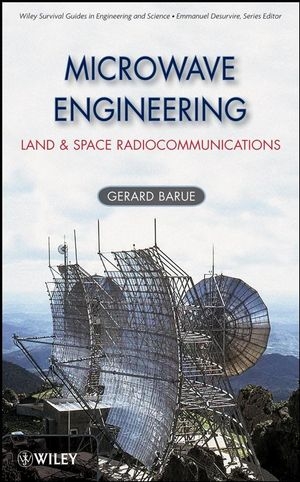
Microwave Engineering
Wiley-Interscience (Verlag)
978-0-470-08996-5 (ISBN)
Everything readers need to implement and support a wireless point-to-point communications environment In order to cope with the tremendous explosion of the telecommunications market, the field of wireless communications has greatly expanded in the past fifty years, especially in the domains of microwave radio systems including line-of-sight, satellites, and tropospheric-scatter. Now, Microwave Engineering: Land & Space Radio- communications answers the growing worldwide demand for an authoritative book on this important and emerging subject area.
In five succinct chapters, the book introduces students and practicing engineers to the main propagation phenomena that are encountered and that must be considered in the design and planning for any given system type and frequency of operation:
Electromagnetic wave propagation—An introduction to the fundamentaltheory of radiation and propagation of electromagnetic waves, polarization, antenna properties, free space attenuation, atmospheric refractivity, diffraction, reflection, multipath and scattering mechanisms, hydrometeor effects, and probability distributions
Principles of digital communication systems—Modulation techniques, signal processing, error probability, spectral characteristics, spectrum efficiency, thermal noise, intermodulation, jamming, and interference
Microwave line-of-sight systems—Path profile, flat fading and frequency-selective fading, interferometric method for space and frequency diversity techniques, International Standards and ITU Recommendations, optimization of the frequency-plan resource, link budget, quality, reliability, and availability
Microwave transhorizon systems—Design of beyond-the-horizon communication systems, properties of scattering and diffraction modes, multipath statistical relations, long-term and short-term field strength variations, quality of service, optimization of antenna alignment, and experimental analysis of various diversity and combining methods
Satellite communications—Design of satellite communications systems, orbital parameters, Earth-satellite geometry, uplink and downlink budgets for both space and Earth segments, and total system noise temperature
Microwave Engineering: Land & Space Radiocommunications is suitable for engineers involved in wireless telecommunications, as well as for students and members of various seminars and workshops.
Gerard Barue is Microwave and Fiber Optic Engineering Manager at THALES Communications. Over the course of the past thirty-five years, he has been responsible for numerous projects relating to air defense and air traffic control as well as civilian networks throughout Europe, South America, Africa, and the Middle East.
Foreword. Preface.
Acknowledgments.
1. Electromagnetic Wave Propagation.
1.1. Properties of Plane Electromagnetic Wave.
1.2. Radiant Continuous Aperture.
1.3. General Characteristics of Antennas.
1.4. Free-Space Loss and Electromagnetic Field Strength.
1.5. Reflector and Passive Repeater.
1.6. Model of Propagation.
1.7. Reflection and Refraction.
1.8. Influence of Atmosphere.
1.9. Propagation by Diffraction.
1.10. Attenuation by Atmospheric Gases.
1.11. Attenuation and Depolarization by Hydrometeors.
1.12. Influence of Ionosphere.
1.13. Thermal Radiation.
1.14. Probability Distributions.
2. Principles of Digital Communication Systems.
2.1. Signal Processing.
2.2. Thermal Noise.
2.3. Digital Communication Systems Design.
3. Microwave Line-of-Sight Systems.
3.1. Engineering of Line-of-Sight Systems.
3.2. Design of Line-of-Sight Microwave Radio Link: Interferometric Method.
3.3. Link Budget.
3.4. Methods of Prediction.
3.5. Protection against Jamming.
3.6. Frequency Reuse Techniques.
3.7. Comparison between Various Diversity Techniques.
3.8. Availability of Microwave Line-of-Sight Systems.
4. Microwave Transhorizon Systems.
4.1. Engineering of Transhorizon Systems.
4.2. Method of Prediction.
4.3. Link Budget.
4.4. Examples of Transhorizon Links.
4.5. Other Models of Prediction.
4.6. Total Availability of Troposcatter Links.
5. Satellite Communications.
5.1. Space Geometry of Satellite Systems.
5.2. Configuration of Satellite Communication System.
5.3. Link Budget.
5.4. Method of Prediction.
References.
Index.
| Erscheint lt. Verlag | 15.8.2008 |
|---|---|
| Reihe/Serie | Wiley Survival Guides in Engineering and Science |
| Sprache | englisch |
| Maße | 163 x 243 mm |
| Gewicht | 767 g |
| Themenwelt | Technik ► Elektrotechnik / Energietechnik |
| Technik ► Nachrichtentechnik | |
| ISBN-10 | 0-470-08996-2 / 0470089962 |
| ISBN-13 | 978-0-470-08996-5 / 9780470089965 |
| Zustand | Neuware |
| Haben Sie eine Frage zum Produkt? |
aus dem Bereich


